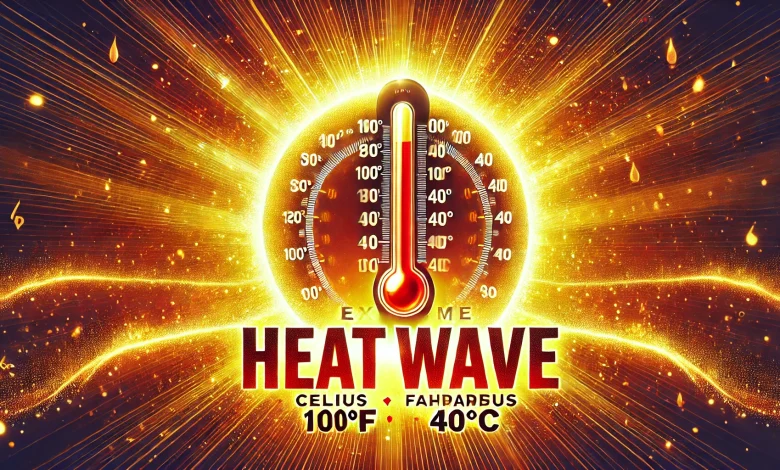Bracing for Impact: Understanding and Responding to a Severe Heatwave Alert

Introduction: What is a Severe Heatwave Alert?
A severe heatwave alert is a formal warning issued by meteorological departments when a region is expected to experience extremely high temperatures for an extended period. This isn’t just another hot day; it’s a serious weather condition that can pose significant risks to health, infrastructure, and the environment. These alerts are issued to help communities prepare for and mitigate the dangers associated with extreme heat.
Unlike standard weather forecasts, a severe heatwave alert implies a higher level of danger. It’s the meteorological equivalent of a red flag. The criteria for issuing such alerts may vary slightly depending on the country or region, but generally, they involve a combination of high daytime temperatures, elevated nighttime temperatures, and the Severe Heatwave Alert persistence of these conditions over several days.
Heatwaves are becoming more frequent and intense due to climate change. The rising global temperatures are altering weather patterns, making extreme heat events not only more common but also more dangerous. A severe heatwave alert should never be taken lightly. It’s a clear signal to take action and stay informed.
The Science Behind Heatwaves
To understand why severe heatwave alerts are so critical, it helps to know what causes heatwaves in the first place. Heatwaves occur when a high-pressure system becomes stationary over an area, trapping warm air beneath it. This system acts like a lid, preventing hot air from escaping and cooler air from coming in. As a result, the Severe Heatwave Alert temperatures keep climbing.
During these events, the ground gets hotter, and because there’s often less cloud cover, the sun’s rays can directly heat the surface. Urban areas suffer even more due to the “urban heat island” effect, where buildings and pavement absorb and retain heat. Cities can end up being several degrees warmer than surrounding rural areas.
Climate change has intensified this Severe Heatwave Alert process. With global average temperatures on the rise, the likelihood of such high-pressure systems forming increases. Not only are heatwaves becoming more frequent, but they’re also starting earlier in the year and lasting longer. This shift has serious implications for agriculture, water supply, and public health.
Health Risks Associated with Heatwaves
When a severe heatwave alert is issued, the first concern is public health. High temperatures can be deadly, especially for vulnerable populations like the elderly, young children, and people with preexisting medical conditions. Heatstroke, dehydration, and heat exhaustion are just a few of the immediate threats.
Heatstroke is a particularly dangerous condition that occurs when the body can no longer regulate its temperature. Symptoms include confusion, rapid pulse, dry skin, and even loss of consciousness. If not treated promptly, it can lead to permanent organ damage or death. Dehydration, on the other hand, can sneak up on people, especially when they’re not aware of how much fluid they’re losing through sweat.
Prolonged exposure to extreme Severe Heatwave Alert heat can also exacerbate chronic conditions like asthma, cardiovascular disease, and kidney problems. Even healthy individuals are at risk if they engage in strenuous activities without taking proper precautions. That’s why heatwave alerts are essential for giving people enough time to adjust their routines and stay safe.
Tips for Staying Safe During a Severe Heatwave

So, what should you do when a severe heatwave alert hits your area? First and foremost, stay hydrated. Drink water consistently throughout the day, even if you don’t feel thirsty. Avoid alcohol and caffeine, as they can dehydrate you further. Eating lighter meals that are rich in fruits and vegetables can also help your body stay cool.
Try to stay indoors during the hottest parts of the day, typically between 11 AM and 4 PM. If you have to go out, wear loose, light-colored clothing, and a wide-brimmed hat. Apply sunscreen with a high SPF and keep physical activity to a minimum. Using fans, air conditioning, or even taking a cold shower can make a big difference in keeping your body temperature down.
Check on neighbors, especially those who are elderly or live alone. Community support can save lives during extreme weather events. Don’t forget about pets either—make sure they have access to water and shade. If your home doesn’t have air conditioning, find out if local authorities have opened cooling centers where you can stay safe.
Impact on Infrastructure and Daily Life
A severe heatwave doesn’t just affect people; it also puts a strain on infrastructure. Power grids often face extreme demand as people crank up their air conditioners, which can lead to blackouts. Roads can buckle, train tracks can warp, and even airplanes can be grounded due to extreme heat.
Water supply can also become an issue. Increased demand for water combined with lower reservoir levels can strain municipal systems. In agriculture, heatwaves can ruin crops, reduce yields, and increase the risk of wildfires. All of this adds up to a significant economic toll.
Daily routines are disrupted as well. Outdoor work becomes hazardous, schools might close, and sporting events are often postponed or canceled. The ripple effect of a severe heatwave can touch nearly every aspect of modern life, which is why preparation and awareness are key.
The Role of Governments and Communities
Governments play a crucial role in responding to severe heatwave alerts. Public awareness campaigns, emergency services coordination, and infrastructure planning all help mitigate the impact. Many cities have started implementing heat action plans that include early warning systems, public cooling stations, and guidelines for vulnerable populations.
Community organizations often step in where government support may fall short. Local NGOs, religious groups, and neighborhood associations can organize check-ins for elderly residents, distribute water bottles, and set up temporary shelters. These grassroots efforts can make a significant difference during a crisis.
Preparedness isn’t just about having emergency plans in place; it’s about building a culture of resilience. Encouraging people to recognize the signs of heat-related illness, preparing homes with proper insulation or cooling equipment, and fostering a sense of responsibility toward others are all steps in the right direction.
Conclusion: Don’t Ignore the Alert
A severe heatwave alert is more than just a weather update—it’s a life-saving warning. As climate change continues to make extreme heat more common, these alerts will likely become a regular part of our lives. The key is to take them seriously, act quickly, and stay informed.
By understanding what causes heatwaves, recognizing the health risks, and knowing how to respond, we can protect ourselves and our communities. Whether you’re staying indoors with a fan or helping a neighbor get to a cooling center, every action counts. Let’s treat heatwaves with the respect they demand and make safety a shared priority.



